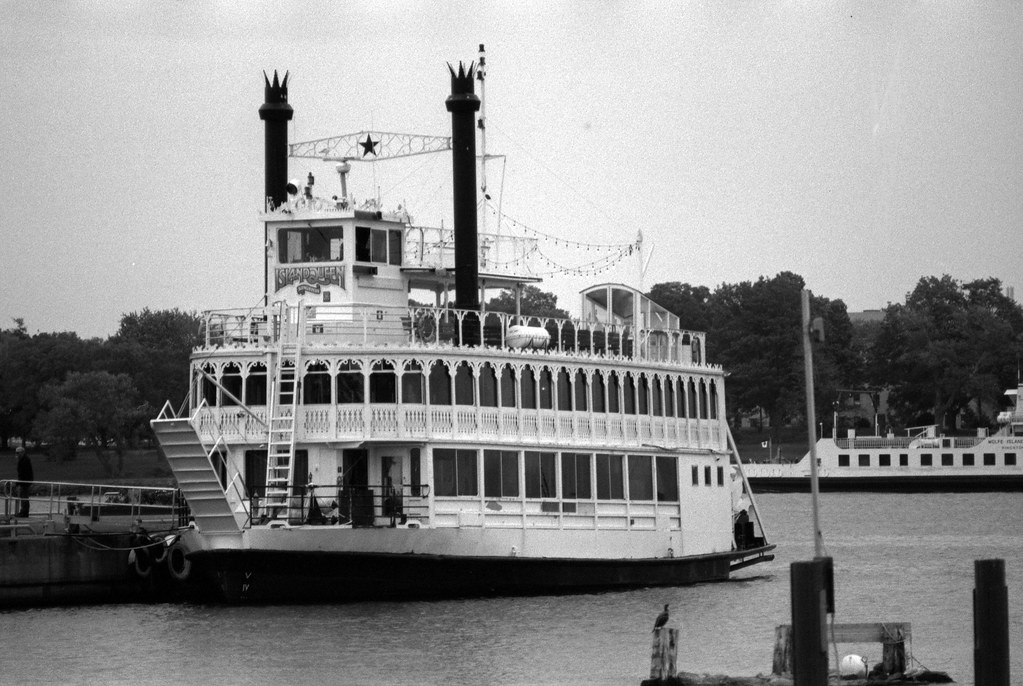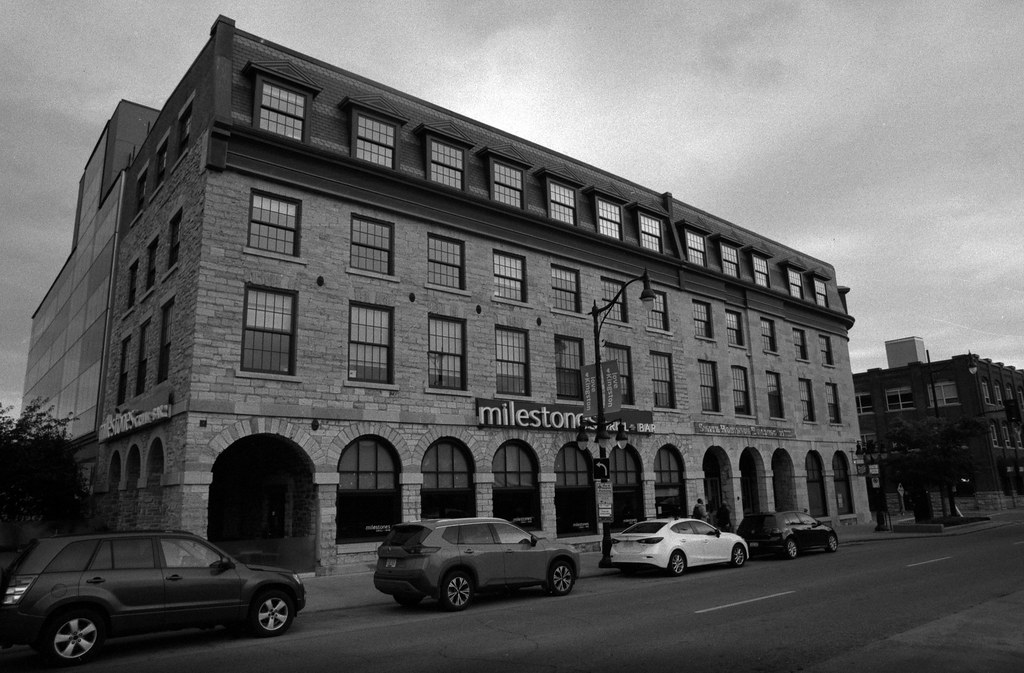Known as Stone City, Kingston is one of Ontario’s oldest cities. The city traces itself back to the early days of colonial settlements in New France. While today the city remains a military stronghold. It has also gone through an identity crisis due to its connection to Canada’s first Prime Minister, Sir John A MacDonald, and his government’s continued role in destroying Canada’s Indigenous peoples.

Nikon FM – AI Nikkor 24mm 1:2.8 – Fomapan 200 @ ASA-200 – Kodak D-23 (Stock) 7:00 @ 20C
The first known human settlement where the modern city of Kingston stands today dates back to around 9,000-3,000 years ago, although the first permanent human settlement would not come until around 500CE. The Hurons would occupy the land until the Beaver Wars, and the Haudenosaunee established their village, naming Cataraqui. The word carried multiple meanings, but the most widely accepted one is “the place where one hides.” European contact came in 1615 when French explorer Samual de Champlain sailed past during his exploration of the Great Lakes. Seeing the site’s potential, the French established a fur trading fort, Fort Cataraqui, later Fort Frontenac in 1673. Tensions between the Haudenosaunee and French traders resulted in the fort’s destruction in 1688, but the French rebuilt shortly after, not wanting to give up a strategic location. By the 1700s, the Haudenosaunee had moved on, and the Mississaugas arrived, as did the British who destroyed the fort during the Conquest of New France during the French-Indian War. The St. Lawerence River Valley became a refuge for United Empire Loyalists in the late 18th century. To help settle these loyal subjects, the Colonial Authorities signed the Crawford Purchase in 1783. They allowed the establishment of a military post and a settlement known as King’s Town on the natural harbour formed where the Cataraqui River flows into Lake Ontario. By 1788 the settlement’s name had been shortened to Kingston. The small village grew, the natural harbour and twin points formed a highly secure location. It quickly outstripped Newark (Niagara-On-the-Lake) and York (Toronto) as Upper Canada’s leading urban centre. The first Grammar School (High School) opened in 1792 and was a hub of military and commercial activity by the century. During the War of 1812, the settlement came under fire from American warships. Still, thanks to the heavy defences along the shore, Point Henry and Point Fredrick saw the American squadron’s driven back. The King’s Navy Yards constructed some of the largest warships in the Royal Navy, including the H.M. Ship St. Lawrence armed with 112 guns, although it never saw action during the conflict. The British constructed a new fort at Point Henry and used the King’s Navy Yard following the war. Even after signing the Rush-Baggot Agreement, the yards became more of holding space for the riggings and arms for the squadron. The village grew into a town by 1838, a bastion of British conservatism that made it the perfect choice for the capital of the Province of Canada. The move was designed to show the French-Canadians their irrelevance and punishment for the preserved blame for the Rebellions of 1837-8. An explosion on the docks in 1840 destroyed the downtown allowing for reconstruction using limestone and earning the moniker the Stone City. Despite being the primary urban centre, Kingston in 1841 had little in services, let alone a sanitary system. Despite the grand designs for a new Parliament building, by 1844, the capital moved to Montreal. The completed building served as the new city hall when Kingston was incorporated as a city in 1846. Through the second half of the 19th century, the city grew, becoming a hotbed for industrial growth and economic trade; one of the first large scale locomotive factories opened, eventually becoming the Canadian Locomotive Company. During the Oregon Crisis, additional defences resulted in a much larger Fort Henry and four Martello Towers. The significant military presence turned the old Navy Yard into the Royal Military College of Canada to educate new generations of officers for the Canadian Militia. During the war, heavy involvement from Kingston saw the old fort used twice as an internment camp and generations of cadets moved out from the college. The post-war saw a gradual decline from industry into an educational and, more recently, tourism realm, with more universities and colleges added to the city. Many downtown buildings once home to industry and supporting ventures are home to restaurants and small shops. The once vast industrial waterfront is home to hotels, condos, and parks. Today, the military remains a significant part of Kingston’s identity and a deep connection with history. The city is home to 1,211 historical sites, 21 of them Federally recognized and one World Heritage Site.

Nikon FM – AI-S Nikkor 200mm 1:4 – Fomapan 200 @ ASA-200 – Kodak D-23 (Stock) 7:00 @ 20C
Nikon FM – AI-S Nikkor 200mm 1:4 – Fomapan 200 @ ASA-200 – Kodak D-23 (Stock) 7:00 @ 20C
The one thing I did my best to do was to avoid anything directly connected to Canada’s first Prime Minister, as the city is still working on putting a more nuanced spin on Sir John A. MacDonald. The trouble is that in Kingston, it is nearly impossible. Thankfully there is plenty to shoot in Kingston that isn’t completely connected to Sir John A; the trouble is that there’s too much to shoot. And when it comes to Kingston, I’ve always faced two limits, time and weather, and this week is no different; despite having a bit more time, the weather wasn’t exactly the best. For the first time, I did not feature the image used in the banner in the blog post; instead, the top photo is the three stages of the city. Starting with the Market Battery from the War of 1812 and through the mid 19th century, the grand City Hwas all built for the Colonial Parliament of the Province of Canada to the modern confederation park. From there, I had to include a rather odd sight, a Mississippi paddle wheeler, another element of the city’s tourism. And, of course, the awesome Shoal Tower, another reminder of the city’s military heritage. From there, it was a matter of showing off the old stone buildings that are now home to hotels and restaurants that directly drive downtown business. And sadly, yes, there is one building that has a connection to Sir John A.

Nikon FM – AI Nikkor 24mm 1:2.8 – Fomapan 200 @ ASA-200 – Kodak D-23 (Stock) 7:00 @ 20C
Nikon FM – AI Nikkor 24mm 1:2.8 – Fomapan 200 @ ASA-200 – Kodak D-23 (Stock) 7:00 @ 20C
This week I decided to run with a two-lens kit, my primary lens being the stunning Nikkor 24/2.8, but I also packed a recent arrival to my stable, the Nikkor 200/4. The only reason I took it with me was to capture some of the Martello towers visible from the downtown, but for the most part, I wanted to get that wide-angle view of the stunning stone architecture. With the light and on-and-off rain sprinkles, I shot the Fomapan 200 at the box speed of ASA-200, and despite the poor lighting conditions, I could get some good shots ensuring that I hit against a flat focal plane. Combined with the ultrawide lens, I was able to get a good depth of field for the architectural work. For the 200mm, I ensured my subjects were a fair distance off as I was often shooting at f/4 to get that 1/250″ shutter speed to avoid any camera shake. I went with Kodak D-23 again; it seems to do one of the best jobs with Fomapan 200, which isn’t bad for a t-grain modern emulsion and a classic one-developing agent developer.

Nikon FM – AI Nikkor 24mm 1:2.8 – Fomapan 200 @ ASA-200 – Kodak D-23 (Stock) 7:00 @ 20C
Nikon FM – AI Nikkor 24mm 1:2.8 – Fomapan 200 @ ASA-200 – Kodak D-23 (Stock) 7:00 @ 20C
We’re back in Toronto and revisiting one of the first dates Heather and I went on; we’re going to the Zoo.
1 Comment